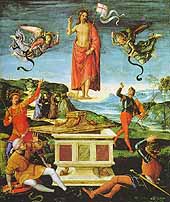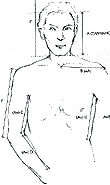
|
Introduction
|

|

 When we study drawing, we first discover what these elements are and afterwards we try to dominate them. Observation drawing is a way to do this, but it is important not to confuse drawing with observation drawing. To represent realistically is only part of the world of drawing, because we can also use the dots, lines and spaces of this graphic language to communicate impressions of reality, not only visual, but also emotional, psychological or intellectual.
When we study drawing, we first discover what these elements are and afterwards we try to dominate them. Observation drawing is a way to do this, but it is important not to confuse drawing with observation drawing. To represent realistically is only part of the world of drawing, because we can also use the dots, lines and spaces of this graphic language to communicate impressions of reality, not only visual, but also emotional, psychological or intellectual.  Through exercises of observation drawing, it is possible to dominate all the visual and graphic elements, which signifies total creative and interpretative liberty, derived from having options. Confidence to experiment with different styles is greater and it is also easier to do expressionist or gestural drawings. Without this skill, one's creativity will always be limited.
Through exercises of observation drawing, it is possible to dominate all the visual and graphic elements, which signifies total creative and interpretative liberty, derived from having options. Confidence to experiment with different styles is greater and it is also easier to do expressionist or gestural drawings. Without this skill, one's creativity will always be limited.
 It is not drawing that inhibits our creativity, but an academic attitude. When observation drawing is taught as if it were based on rules, then, really, it will harm one's creativity, just as any teacher, who imposes rules, styles or solutions, discourages students to search for a personal means of expression. I must emphasize that observation drawing is a means to master drawing, and it is only when we obtain this skill that our art becomes totally free, in which no option or solution is excluded due to a lack of knowledge.
It is not drawing that inhibits our creativity, but an academic attitude. When observation drawing is taught as if it were based on rules, then, really, it will harm one's creativity, just as any teacher, who imposes rules, styles or solutions, discourages students to search for a personal means of expression. I must emphasize that observation drawing is a means to master drawing, and it is only when we obtain this skill that our art becomes totally free, in which no option or solution is excluded due to a lack of knowledge.
 You will notice that gradually you will apply this type of thinking to other activities, both personal and professional. You will become more critical of your surroundings and more sensitive and creative in general. Your family and personal relationships will be enriched. It has become apparent to me that drawing is a very powerful educational instrument, with a much wider scope than I had at first thought. Artistic expression and drawing are means for intellectual, emotional, spiritual and creative enrichment. All this puts obtaining an artistic product in second place, at least at the beginning of one's studies.
You will notice that gradually you will apply this type of thinking to other activities, both personal and professional. You will become more critical of your surroundings and more sensitive and creative in general. Your family and personal relationships will be enriched. It has become apparent to me that drawing is a very powerful educational instrument, with a much wider scope than I had at first thought. Artistic expression and drawing are means for intellectual, emotional, spiritual and creative enrichment. All this puts obtaining an artistic product in second place, at least at the beginning of one's studies.
 The right hemisphere of the brain is much less developed in most people, because, not only is the left hemisphere dominant, but also traditional education has privileged the development of the left's attributes: logic, reasoning, abstraction, symbolism, linear, detailed and analytical thinking, and verbal, temporal and digital-arithmetic conceptions. Furthermore, according to Dr. John C. Eccles, it is on the left side that the concept of self is formed.
The right hemisphere of the brain is much less developed in most people, because, not only is the left hemisphere dominant, but also traditional education has privileged the development of the left's attributes: logic, reasoning, abstraction, symbolism, linear, detailed and analytical thinking, and verbal, temporal and digital-arithmetic conceptions. Furthermore, according to Dr. John C. Eccles, it is on the left side that the concept of self is formed.
 Drawing is also important in the development of expressiveness, sensibility and intuition, or insight. While drawing, it is the process in which you are involved that is important, and not the product which is a result of this process. For the artist, pleasure is found creating a work, and not in the finished work itself. It is important for you to remember this, because you should not be concerned with the finished drawing, but with the process of learning and discovery. You should concern yourself with understanding and mastering the elements which form the visual art work, and then the product will be a natural consequence of this understanding.
Drawing is also important in the development of expressiveness, sensibility and intuition, or insight. While drawing, it is the process in which you are involved that is important, and not the product which is a result of this process. For the artist, pleasure is found creating a work, and not in the finished work itself. It is important for you to remember this, because you should not be concerned with the finished drawing, but with the process of learning and discovery. You should concern yourself with understanding and mastering the elements which form the visual art work, and then the product will be a natural consequence of this understanding.
 The right hemisphere works with other attributes, less important, but also very valuable, for most of our daily activities: analogies, synthesis, intuition and concrete, spatial, geometric and holistic concepts. The right side is also the musical side. In fact, music and observation drawing are what best develop this type of thinking, to my knowledge. Based on this knowledge, I believe that art education should be used primarily to develop the thought processes of the right hemisphere of the brain, to enhance perception and as a means to express oneself emotionally and creatively.
The right hemisphere works with other attributes, less important, but also very valuable, for most of our daily activities: analogies, synthesis, intuition and concrete, spatial, geometric and holistic concepts. The right side is also the musical side. In fact, music and observation drawing are what best develop this type of thinking, to my knowledge. Based on this knowledge, I believe that art education should be used primarily to develop the thought processes of the right hemisphere of the brain, to enhance perception and as a means to express oneself emotionally and creatively.
| LEFT SIDE | RIGHT SIDE |
| Related to Consciousness | No such relationship |
| Abstract and Symbolic | Concrete |
| Conceptual | Intuitive |
| Sequential-Linear and Detailed | Holistic |
| Analytical | Synthetic |
| Logical and Rational | Analogical |
| Temporal | Synthesis of Time |
| Verbal | Musical (Almost Non-verbal) |
| Linguistic Description | Pictorial and Formal Sense |
| Digital Conception (Arithmetic and Computation) | Spatial (Geometry) |
|
|
| E-mail:maolivre@cybermind.com.br |